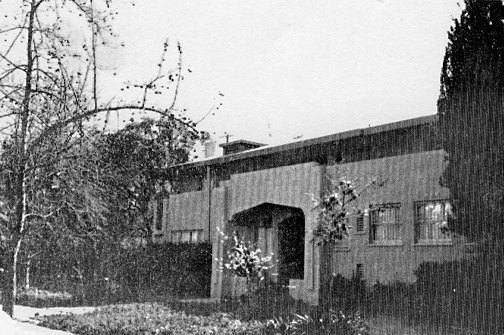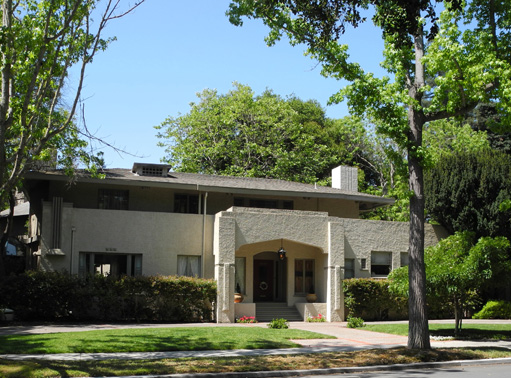 Palo Alto Stanford Heritage
Palo Alto Stanford Heritage |
 |
| Inventory phhoto taken 1978. | 2014 photos of side and street view of 1680 Bryant. |
The following is from the from the Historic Buildings Inventory as revised in 1985:
A two–story stucco building at 275 Lowell was originally joined to the principal building at 1680 Bryant to form a single family residence. A one–story connecting wing was bulldozed in the mid–20th century creating two separate houses. It is a superb example, even in its mutilated state, of John Hudson Thomas' ability to fuse Prairie Style, Secessionist, Craftsman and Pueblo Revival architectural expressions.
This is a milestone design in the career of an important Bay Area designer, John Hudson Thomas.
The original owners were Harry Lewis Haehl and wife Mary (Burrel). Haehl (1877–1949) was a mining and civil engineer who, after taking his engineer degree from Stanford in 1901, lived in Palo Alto until his death. He served on the board of the city's high school district until unification of the school system.
In 1936, the property was purchased by Frank J. and Eugenia (Jean) M. Frost, who divided it and added a studio. Frost was a distinguished amateur musician and patron of music. He was trained as a mining engineer who became treasurer of Standard Oil of New York and vice–president of Guaranty Trust Co. Upon retirement of Ojai, he established Ojai Valley School and the Ojai Music Festival in the early 1920s. Moving to Washington, D.C., he founded the National Symphony Orchestra and Washington String Quartet. The Frosts came to Palo Alto in 1935, and their home and studio became a community music center. Mrs. Frost was president of the International Woman's league for a number of years, and, after her husband's death in 1939, retained the house until the early '50s.
. . . The portion of the property at 1680 Bryant Street was first occupied separately in 1946 by W.S. Allen, Jr., followed (1955–1966) by Charles J. (Jerry) Simpson and his wife Venice. Simpson was a labor relations expert; his San Francisco firm, the National Labor Bureau, at one time represented more that 200 Bay Area labor unions. His pioneer ancestors included the first judge in Madera County, a pioneer landscape architect who helped Luther Burbank plan the landscaping for early Los Angeles, and (his father) an early leader in the Los Angeles lumber and sash–and–door industry.
Following the Simpsons from 1968 through the 1970s were Clayton O. and Tannisee Rost; Rost was an attorney in the law firm of Elliott Robertson and Rost. At the date of the Inventory, Laszlo and Maria-Paula Hadju were the owners.
The home changed hands most recently in 2014.
This stucco house was built in 1914 and is a Category 2 on the Historic Buildings Inventory. It was presented with a centennial plaque in 2014. The architect was John Hudson Thomas, but the original builder is unknown. The 1936 addition was by Aro and Okerman. The 275 Lowell section was demolished and replaced.
Sources: Palo Alto Times 12/18/36, 4/15/39, 9/19/68; Bay Area Guide to Architecture; Palo Alto Historical Association files
| |
E-mail us at either webmaster@pastheritage.org or president@pastheritage.org.
![]() Palo Alto Stanford Heritage—Dedicated to the preservation of Palo Alto's historic buildings.
Palo Alto Stanford Heritage—Dedicated to the preservation of Palo Alto's historic buildings.
Copyright © 2015 Palo Alto Stanford Heritage. All rights reserved.